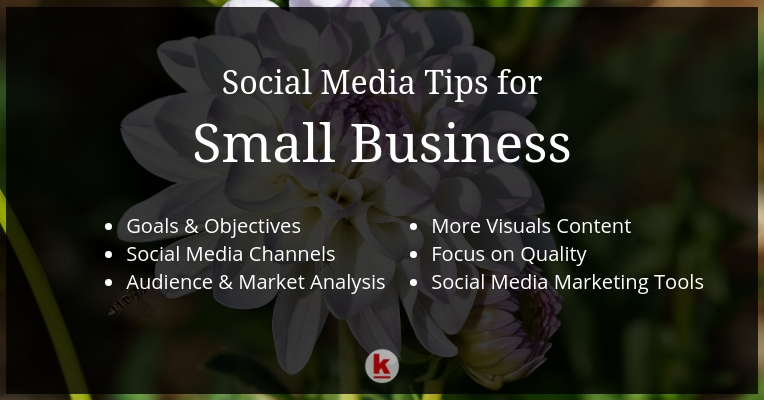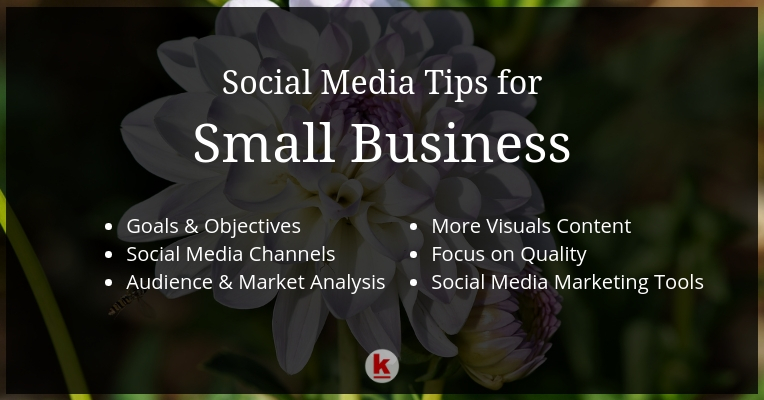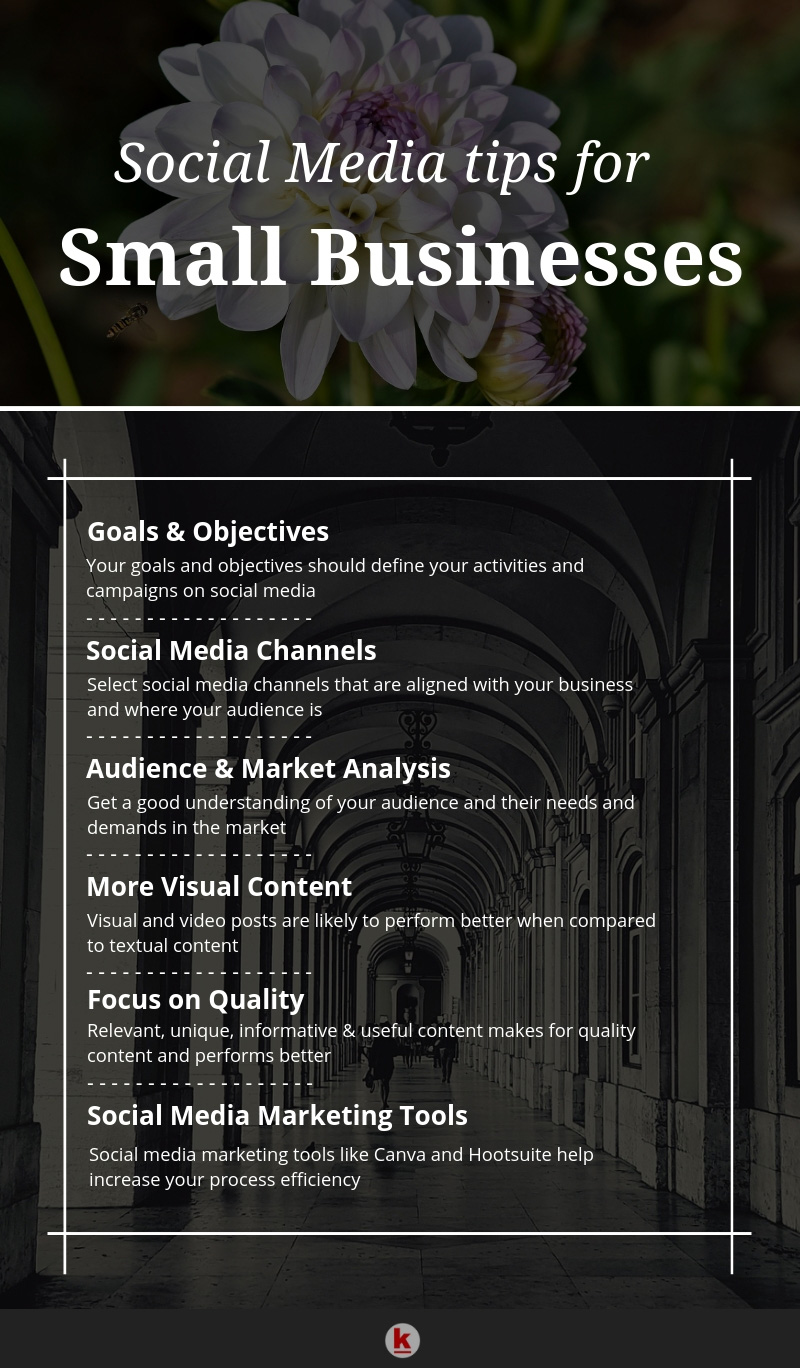
6 Social Media Marketing Tips for Small Businesses

Social media is one of the most powerful tools all of us have access to in today’s world. It lets us stay connected to friends, family, people outside of those two categories, brands, organizations and so much more. Each one of us checks our social media accounts at least once a day, whether it’s trying to look for knowledge or information, or just scrolling through pottery or cat videos.
However, social media is much more than that. For business owners and brands, it’s a medium they can utilize to bring in more business, generate more revenue, increase brand awareness and achieve other professional or personal goals. Businesses have been using social media to attract consumers like us ever since the concept of social media emerged. We all spend some amount of time on our preferred social media channels, and marketers around the world thought of it as a perfect opportunity to target us as potential customers.
Soon, businesses started to do more and more with social media. With a combination of rich media, high-quality content and personalization, social media has become the most preferred way for businesses to connect with their audience. Social media led to some of the best marketing campaigns and some of the healthiest growths in business – all thanks to correct utilization and well thought out marketing strategies.
So if you’re a business owner who’s trying to figure out how to use social media for your small business, we’re happy to know you’re finally thinking about it! But just like any other business action needs a plan, you’ll need to create a social media plan for small business.
Here are some social media tips and tricks:
Goals & objectives
Like all other activities in a business work towards a goal, your purpose behind being present on social media should be backed by a goal you are trying to achieve. Sure, you can be on social media just to be there. But that is unlikely to bring more success and business.
Having a clear goal in mind such as increasing awareness or lead generation can help implement and execute social media campaigns better. If you know that your end goal is to generate a lead, you’ll make sure from the beginning that your decisions and posts are aligned with that goal.
Here’s are a few reasons businesses want to be present on social media:
- To announce offers or promotional discounts
- To handle negative comments and manage brand reputation
- To solve customer pain points and problems they face
- To launch a new product
- To upload information or knowledge in their field of expertise
- To add a human touch to their business
- To always stay in the sight of potential customers
- To partner with influencers & bloggers
The list goes on but you get the gist! There are a million reasons for your small business to be on social media. Like we said above, all these activities are supported by an end goal or objective.
It may seem like setting your goals and objectives isn’t really a ’social media tip’, but it is one of the most important things businesses skip on. They don’t spend enough time figuring out why they must be on social media. But think about it, if you don’t know why you’re there, how will you know what you want from it?
Social media audit
Now that you know what you want to achieve by being on social media, it’s time to select the channels you want to be present on. When we hear the term social media, we usually think of Facebook, Twitter and Instagram. But what some business owners don’t know is that there are other channels like Skill Share, Snapchat or LinkedIn which also count as viable social media channels. In fact, our social media experts at RedAlkemi believe that Facebook will soon phase out.
Of course, there are channels we recommend presence on simply because they are the most common ones. These include Facebook, Instagram, Twitter & Google+.
Coming back to our point, you need to select channels that are:
- Aligned with your business – if you’re blockchain consultant that helps companies plan business strategies, we recommend being present on LinkedIn, Skill Share and Twitter.
- Preferred social media channels for your target audience – if you’re Vintage Transport Museum, we recommend being on Instagram, Pinterest & YouTube becasue your target audience is probably on those channels!
- Aligned with the type of content you want to publish – if you’re a divorce paralegal who only publishes information based blogs, we probably don’t recommend Instagram. Instead, you could build a strong presence on LinkedIn and blogging platforms.
Another great way to select your social media channels is to keep a close check on what your competitors are doing. We don’t mean you should do exactly what your competitors do, but keeping a close check can help you identify mistakes your competitors are making, as well as the strategies that work for them and are likely to work for you. It also helps save time that you would have spent doing the same research they did!
You should also know that it’s not necessary for you to carry on with activities that do not work for your business. The perfect example of this is Snoozer – a luxury mattress brand we market on social media. Snoozer used to be present on Facebook, Twitter & Instagram. But in a country like India, there just weren’t enough people who would be interested in a luxury mattress and were present on a channel like Twitter! To put it simply, Snoozer’s target audience was not present on Twitter. So instead of wasting our time and energy on Twitter, we focused on other platforms that did bring us more results, such as Facebook and Instagram.
Audience & market analysis
Our Snoozer story probably gave you a good hint about this step. A thorough audience & market research.
Understanding your audience, what they like, what they dislike and why they dislike it is an important factor that will determine your social media activity. Whatever you post on your social media channel should resonate well with your target audience.
If your target audience was squished into one person, would you think you know everything about their preferences? How well do you know your target audience?
Does your target audience need the new iPhone?
Or does your target audience need the latest Harry Potter collection with the updated book covers?
Or does your target audience want both?
It’s both interesting and challenging to get to know your target audience in ways you’ve never imagined before. But creating this persona and preempting your audiences’ behaviour is what will lead you to success on social media platforms.
Is your target audience the kind that will willingly participate in short quizzes or online contests? Is your target audience the kind that appreciates subtle marketing and a story behind every post you upload? Answers to these questions will help you create content specific to the likes of your audience.
There’s a great online tool called Xtensio, that can help you create a user persona for your business.
Other than their preferences, you must also be aware of the needs and demands of the market. This could be as simple as needing more sunscreen during peak summer or as well thought-out as promoting new styles of phone cases on the same day as Apple releases their new iPhone.
Careful and detailed planning is likely to bring you more success as compared to throwing shots in the dark and hoping something will work out for your business.
More visuals
We’re sure you already witnessing the shift of consumers’ preferred type of content from text to pictures to videos, including yourself. What we can learn from the past and the present is that visual content works better for social media. Sure, people love to consume textual information when they really need it, but if you ask anybody if they’d rather read a 2000 word blog or watch the same content wrapped up in a video, they’ll want to watch the video.
Visual content is not only easier to recall, it also has a much greater impact. If somebody tried recapping their beautiful experience of scuba diving in the Maldives in a blog, we’re sure it wouldn’t be as interesting as a video of them actually scuba diving. You’re likely to remember the video for longer, but what’s great is that you’re likely to share it with more and more people too.
Visual content gives the viewer’s more details like colour, movement, a deeper and more meaningful story and possibly what happened before and after.
Thankfully, there are so many different ways of visual communication on social media! More and more businesses make use of GIFs, live stories, boomerangs, and by using augmented reality such as Snapchat filters. Technology has given us plenty of creative ways to keep in touch with our target audience while keeping them engaged too!
Focus on quality
No matter what kind of content you choose to put out, who your content is for or what channels you select to publish this content, quality content will always perform well.
One of the biggest differences in content that makes it big and content that didn’t perform so well is the difference in quality.
If your business focuses on publishing content that is informative, unique and useful content, your target audience will consume it.
People looking for information that could help solve their problems will always be willing to read more and more content. So if you offer a solution to their problem, answer their questions or simply publish something that could help them in any way, you are creating good quality content.
Creating quality content may seem like an easy task, but it takes time and effort to create it. Once you start doing this, you may not be able to post as frequently as you used to – but your chances of success are higher if you choose to publish high-quality content.
If you like, check out this blog we wrote on how to write quality content. If you don’t have the time to go through the entire blog, here’s the gist of it:
- Identify your purpose of writing content
- Use a strong headline to attract more users and clicks
- Ask questions to your audience that make them think
- Display a contrast between two topics of discussion
- Tell a story through your content
- Use metaphors or phrases to make your content richer
- Share research statistics, facts and numbers
- Personalize your content for your target audience
- Use powerful vocabulary that has a greater impact
Social media marketing tools
It’s time to finally discuss the aspect of social media that brings all of our points together.
Social media marketing tools.
For business owners to handle social media and all that it has to offer can be a bit of a nightmare. A few reasons for this could be:
- You don’t have a good understanding of what needs to be done
- You don’t have enough time on your hands to handle this aspect of your business
- You don’t have enough financial resources to outsource this work
- Even if you outsource it, your marketing team isn’t doing a great job
- You just don’t want to get into it and have one more thing to handle
We believe that there are a bunch of tools out there that address these problems and make it easier for you or your marketing team to handle your social media presence. Here’s a list of some of our favourite free tools and what they help us do:
Design – In the visual world of social media, a tool like Canva can help you design simple and beautiful graphics for your business. It allows you to create templates for consistency in design and it also offers free illustrations, photos and templates.
Posting Automation – For those who don’t have the time to post something every single day, our favourite marketing automation tool Hootsuite allows us to do it all in one go. The free version lets you upload 30 posts at any given time for up to 3 social media channels. It’s a great way to keep track of your social media calendar!
Content Curation – For companies like us who are always looking for new trends or new topics to publish content on (yes, even digital marketing companies have to do this), we love using BuzzSumo. It’s a great platform to discover new content and engage with content similar to yours.
Tracking & Analysis – With every social media marketing campaign comes a full report of its performance. Tracking and analyzing data helps you create better social media campaigns in the future. Our favourite tool for this is Google Analytics.
The more you spend time using these tools, the more you understand the benefits it brings along. Using these tools makes your processes faster and more efficient, bringing you greater results.
As a Digital marketing agency, we understand the importance of being present on social media. Whether it’s to handle brand reputation or publishing content, social media is the need of the hour for any business. It is yet another technique to grow your business and we highly recommend it!
RedAlkemi is always open to publishing unique, informative and original content on the RedAlkemi blog! Take a look at our guest posting terms.
